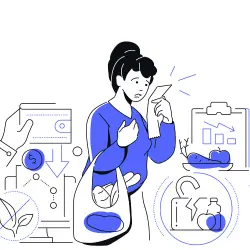TABLE OF CONTENTS

Ever since 2004, when the US officially adopted electronic checks with the Check Clearing for the 21st Century Act (or Check 21), traditional checks have seen a drastic decline in their use. This is because electronic checks are much faster, more reliable, and more secure. But not only that—eChecks also make a substantial contribution to environmental concerns as they produce absolutely no paper waste.
This article will focus on what’s an eCheck, how to send an electronic check, the perks, and how to set it up in your business.
What Is an eCheck?
An eCheck, short for electronic check, is a digital version of a traditional paper check for online payments and transactions. Electronic checks directly transfer funds between bank accounts for individuals and businesses. It’s important to note that eChecks work through the Automated Clearing House (ACH) network, a secure and regulated system that facilitates electronic fund transfers between banks in the United States.
With eChecks, you can make various types of payments similar to those made with traditional paper checks, but in a more convenient and electronic format. That’s why one must know how to send an eCheck. Here are some common types of eCheck payments:
- Online Purchases: Electronic checks are great for making payments for goods and services when shopping online. Many eCommerce websites offer eCheck as a payment option alongside credit cards and other digital payment methods.
- Bill Payments: Electronic checks are commonly used to pay various bills, such as utility bills, rent, mortgage, insurance premiums, and other recurring expenses. Many billing companies accept eCheck payments through their online portals or over the phone.
- Subscription Payments: For subscription-based services, eChecks can be accepted on a recurring payment basis.
- Business-to-Business (B2B) Payments: Companies use eChecks for business transactions. They are often preferred for paying suppliers, vendors, contractors, and other business-related expenses.
How to Send an eCheck
Sending an eCheck typically involves initiating the payment through a payment gateway that supports electronic check transactions. Below is a step-by-step guide on how to send an electronic check:

1. Find an eCheck service
To find an eCheck service, search online for an eCheck service provider. Check each provider’s pricing, security, and available payment methods on their official websites. Furthermore, check for available integration options and ensure reliable customer support. And if you want to operate internationally, the service should also offer cross-border transactions.

2. Input payment details
The next step of how to send an eCheck involves payment details.
- Gather Bank Account Information: Obtain the necessary bank account information required for the eCheck payment. You will need the bank’s routing number and account number, as well as the account holder’s name.
- Choose Payment Method: When making a purchase or payment online, select eCheck as the payment method during the checkout process.
- Provide Bank Account Information: Enter the required bank account information into the appropriate fields on the payment page. Some platforms may also ask for additional details like a billing address or the customer’s contact information.

Authorize the Payment
The last step of how to send an electronic check is to authorize an eCheck payment. You may need to provide consent through some Authorize Payment button, digital signature, or acceptance of payment terms. Once you submit the payment request, the payment processor verifies your bank account details and funds availability. The eCheck is then processed through the ACH network, transferring funds from your account to the recipient’s account. After completion, you receive a confirmation email or notification of the successful eCheck payment.
How to Send an eCheck From Your Bank
Knowing how to send an eCheck through your bank also has its perks. Sending an eCheck from your bank is a secure and convenient way to make electronic payments. The process involves setting up online banking, logging in to your account, linking a payment method, initiating the payment, selecting eCheck as the payment method, entering recipient and payment details, reviewing and confirming the transaction, and authorizing the payment. Once sent, you’ll receive a confirmation, and the recipient will be notified.
Specific steps may vary by bank, so contacting customer support for assistance is advisable. Watch out for potential fees associated with eCheck usage.
How to Send a PayPal eCheck
Are you wondering how to send an electronic check with PayPal? Well, you technically can’t.
If you make a PayPal payment without linking a debit or credit card to your account, the payment will be converted into an eCheck. Electronic checks typically take up to 7 business days to clear, though occasionally it may take longer. To speed up future padyments, consider adding a credit or debit card to your PayPal account as a backup payment method. This will allow you to pay instantly from your bank account when needed.
PayPal advises that before sending an eCheck, you ensure that you have sufficient funds in your bank account, as a lack of funds may result in a declined payment. If the first attempt is unsuccessful, PayPal will try again within 3 business days. However, if your bank declines the payment a second time, PayPal will cancel the transaction, resulting in a penalty fee.
Please note that if an instant transfer option is available, you won’t be able to send an eCheck, as the instant transfer will take precedence.
Advantages of Using eChecks
Using eChecks offers several advantages, making them a preferred method of payment for many businesses. These are some of the key advantages of using eChecks:
- Convenience: With eChecks, customers can make a payment from the comfort of their home or office through online banking platforms or payment gateways.
- Cost-Effective: Electronic checks typically carry smaller processing fees, which can result in substantial savings, especially for businesses that process a large number of payments.
- Security: The transfer of eChecks is encrypted, reducing the risk of fraud or identity theft compared to physical checks that can be intercepted.
- Fast Processing: While eChecks may take a few days to clear, they help merchants avoid mailing and manual processing delays. For recurring payments, you can set up eChecks for automatic processing, which saves significant time.
- Accessibility: You can also use eChecks for both domestic and international transactions, making them a versatile payment option for businesses operating globally.
- Ease of Record-Keeping: Electronic transactions provide clear and easily accessible records of payments. This can simplify accounting and financial planning, reducing the chances of human errors.
- Environmentally Friendly: By eliminating the need for paper checks and reducing paper waste, eChecks contribute to a more eco-friendly approach to financial transactions.
How to Set Up eCheck Payments for Your Business

To set up eCheck payments for your business, start by establishing clear payment policies, including fees, return/refund procedures, and processing times to avoid confusion.
Next, find a reputable merchant service provider that prioritizes security and fraud prevention. A suitable provider can provide you with the necessary tools for you to accept eCheck payments. Be sure to look for features like recurring billing options, end-to-end encryption, and data analytics.
Once your provider assists you with linking your business bank account, be sure to integrate the eCheck payment option with your website. Regularly monitor the payment channel for any errors and promptly address customer concerns.
Sending Checks Electronically: FAQs
Can you send an eCheck through email?
Yes, you can. Some payment services and platforms offer the option to send an eCheck to an email address. In this case, the recipient receives an email with instructions on claiming the eCheck and providing their bank account information for the transfer. This method adds a layer of security by not directly including sensitive banking information in the email itself.
How long does it take to process an eCheck?
After sending an eCheck, verification typically lasts for 24-48 hours. However, it’s important to note that depending on factors such as processor, banks, working days, and time of day you might observe the funds in your business bank account as early as the following business day.
Are eChecks traceable?
Yes and no. Electronic checks are traceable only within the financial systems, but the general public doesn’t have direct access to this information. Regarding security and privacy, eCheck transactions are maintained through secure banking systems, protocols, and encryption.
How do I accept an eCheck?
To accept eCheck payments:
- Set up online payment processing with an eCheck-supported gateway.
- Verify your business bank account linked to the processor.
- Communicate eCheck acceptance and securely ask for bank account information from customers.
- Allow the payment processor to transfer and verify the transfer.
- After clearance, you will receive confirmation and can inform customers of the clearing period.






